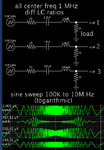Hawaslsh
Full Member level 3
- Joined
- Mar 13, 2015
- Messages
- 164
- Helped
- 5
- Reputation
- 10
- Reaction score
- 7
- Trophy points
- 1,298
- Location
- Washington DC, USA
- Activity points
- 3,422
Hello all,
I had some questions about my HFSS setup and results for a RFID near field coil. Forgive me if i can't provide all the details, many are "company confidential", but i will do my best to be general and provide what I can.

From the company that designs the RFID chip, I was given some antenna parameters to match to, see picture above. We are working with etched antenna patterns, so the two coil terminals are not physically connected, only capacitivity coupled, see picture below.

My goal is to create a simulation which can predict the series L and R for the coil at 1 MHz. I created a HFSS simulation the best I could, but have run into some questions / problems.
1) When i define a lumped port between my terminals, i am forced to choose a port impedance (which makes sense) but i feel it is perturbing my results by add a 50ohm connection which doesn't really exist. Is a lumped port really the best way to proceed here? Do you think it is wise to simply put the conjugate match [ from the picture above (Rs-Ls) ] as the port impedance?
2) From this type of simulation, what results would actually show the series Rs and Ls of the coil. Is it simply Z11? Since I am using a lumped port, Zo seems out of the question since its always 50 ohms.
I am sure there are more problems than the two I just asked, but any advice, guidance, or help would be much appreciated. I will attach my HFSS file here, its from vr 15. Let me know if you need any more details about the problem.
Thanks in advance,
Sami Hawasli
View attachment Intial testing.zip
I had some questions about my HFSS setup and results for a RFID near field coil. Forgive me if i can't provide all the details, many are "company confidential", but i will do my best to be general and provide what I can.
From the company that designs the RFID chip, I was given some antenna parameters to match to, see picture above. We are working with etched antenna patterns, so the two coil terminals are not physically connected, only capacitivity coupled, see picture below.

My goal is to create a simulation which can predict the series L and R for the coil at 1 MHz. I created a HFSS simulation the best I could, but have run into some questions / problems.
1) When i define a lumped port between my terminals, i am forced to choose a port impedance (which makes sense) but i feel it is perturbing my results by add a 50ohm connection which doesn't really exist. Is a lumped port really the best way to proceed here? Do you think it is wise to simply put the conjugate match [ from the picture above (Rs-Ls) ] as the port impedance?
2) From this type of simulation, what results would actually show the series Rs and Ls of the coil. Is it simply Z11? Since I am using a lumped port, Zo seems out of the question since its always 50 ohms.
I am sure there are more problems than the two I just asked, but any advice, guidance, or help would be much appreciated. I will attach my HFSS file here, its from vr 15. Let me know if you need any more details about the problem.
Thanks in advance,
Sami Hawasli
View attachment Intial testing.zip

